Seals of Harappan Civilization- Indus Valley Civilization Seals, UPSC PDF
By BYJU'S Exam Prep
Updated on: November 14th, 2023
The seals of Harappan civilization were one of their culture’s exceptional and artistic innovations. Since 1921, approximately 3500 Indus valley seals have been discovered. The Indus Valley Civilization is the first well-known metropolitan civilization flourishing on the Indus riverside. Indus Valley Civilisation constructed a lot of artifacts and art structures, such as seals of Harappan civilization. Indus Valley art form appeared during the second half of the third millennium Before the Common Era or BCE (i.e., from 2500 BC onwards). Read the article to get complete details pertaining to the seals of Harappan civilization.
Innumerable sculptures, crockeries, seals, jewels, and other antiques have been unearthed from these locations. The standard seals of Harappan civilization had a square shape with a dimension of 2X2. Most Harappan seals are comprised of materials like chert, ivory, gold, copper, steatite, terracotta, faience, and agate. This article will explain the nature, types, importance, and characteristic features of seals of Harappan civilization.
Table of content
Seals of Harappan Civilization – History
All the seals of Harappan civilization have images of animals with written pictographic calligraphy (yet not translated). The Harappan seal symbolized many animals, including bulls, bison, elephants, tigers, goats, etc.
- It is known that there stood something written on both sides of Harrapan seals.
- The handwriting discovered was from the right-to-left direction in the Kharosthi style.
- Few seals of Harappan civilization even had mathematical illustrations and were known to be utilized for scholastic objectives.
- Pashupati Seal of Harappan civilization was the most recognized from Mohenjo Daro.
- This seal had a figure who sat cross-legged in the middle with animals, including a rhino and a buffalo to its left and an elephant and a tiger to the sculpture’s right.
Seals of Indus Valley Civilization
Seals of Indus valley civilization were miniature entities inscribed out of pebbles and heated to create more durability in ancient times. Most of the seals found in Harappa were located near Lothal, the seaport of the Indus Valley Civilization.
- Many Harappan seals have also been discovered in Central Asia, Mesopotamia, and along the shores of the Arabian Peninsula.
- The major utilization of Mesopotamia seals was in trading between the Mesopotamia and Harappan civilizations, the world’s two great ancient civilizations.
- Some seals of Harappan civilization were encountered upon mortal bodies bearing threaded voids, indicating that they were used as talismans or as a piece of jewelry.
- The seals of Indus Vallley civilization in various regions are of diverse shapes and sizes. The Indus valley civilization seals come in square, triangle, rectangle, and circle shapes, but the square one was the most familiar form in the Harappan civilization.
Pashupati Seal of Indus Valley Civilization
The most popular seal of the Indus valley civilization is the Pashupati seal. It is a seal made of steatite (the mineral talc, particularly as soapstone) with an engraved figure of a human, possibly a divinity, named Pashupati.
- He is depicted in the seal wearing a three-horned headpiece encircled by animals, including a tiger and an elephant on the left side, two antelopes below the figure, and a rhinoceros, a buffalo on the right side.
- There are seven Indus writing symbols at the top of the seal, the last of which seems to be displaced in the downward direction due to a lack of horizontal space.
- The measurement of the steatite seal is 3.56 cm by 3.53 cm and has a breadth of 0.76 cm.
- It features a man’s figure posing on a floor and facing towards the center.
- The sculpture’s legs along the knees are twisted, with the heels in contact and the toes in the downward direction.
- The figure is garnished with an elevated and decorated hat with a mid-fan-shaped layout surrounded by two gigantic streaked horns.
Types of Indus Valley Civilization Seals
Below are important seals of Indus valley civilization. Their carved description and image are provided to understand the exact significance of the Harappan seal. The aspirants preparing for the UPSC exam must be proficient with the complete details of the seals of Harappan civilization.
|
Type of Harappan seal |
Information About Seals of Harappan Civilization |
Image |
|
Large unicorn seal |
It is one of the biggest seals in any Indus area. |
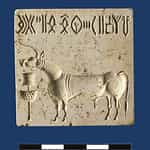 |
|
Intaglio seal with script and unicorn |
Intaglio seals of Harappan civilization were found in approximately 2200 BCE, at the transition between Harappa 3B and 3C Generations. |
 |
|
Steatite button seal |
This seal incorporates four concentric circle arrangements. |
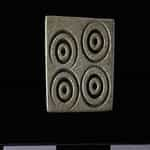 |
|
Faience button seal |
It contains a geometric pattern. |
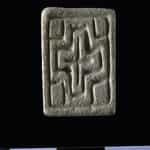 |
|
Unicorn seal |
A square steatite seal with a unique caption. The two clusters of signs on the right-hand boundary of the seal seem to be in opposite directions, i.e., on the left, when it was squeezed into clay. |
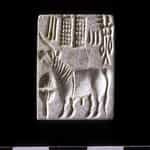 |
|
Unicorn seals of Harappan civilization comes from classes dating to Harappa Phase Period 3B. |
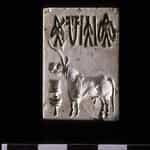 |
|
|
Seals from Mohenjo-Daro |
Rare Three Animal whose multiple-heads include three vital totemic animals: the bull, the antelope, and the unicorn. Animals appear separately along with the handwriting, but this seal has no script. |
 |
|
Seals of Harappan civilization from Mohenjo-Daro depict a naked male god with three faces that sat in a yoga position on a crown, having a bracelet on either arm and an intricate cap. One stem with three pipal leaves ascends from the center of the hat. |
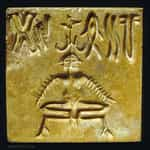 |
|
|
Seal depicting a divinity with a horned hat, standing in a pipal (holy fig) tree, wearing bangles on both arms, and glancing down at a kneeling worshiper. A human head rests on a little stool. |
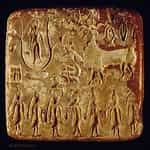 |
|
|
Bull seal, Harappa |
The glorious zebu bull is the most special motif with a hefty jawbone and broad curving horns, seen on the Indus seals. The zebu bull represents the most powerful clan or top officials of Mohenjo-Daro and Harappa. |
 |
|
Bison seal, Mohenjo-Daro |
It is a flat square seal being double-sided. A Swastika design is carved on the reverse, spinning counterclockwise. |
 |
Importance of Seals of Harappan Civilization
The seals’ main purpose was retail. Some of the seals of Harappan civilization were carried to depict a kind of identity card as charms. A few Harappan seals were also utilized during spiritual ceremonies or special rituals. The seals were competent in conveying legendary tales.
- Most of the seals found in Harappa were primarily used for purposes like sealing the jars by pushing the seals against soft clays, creating clay labels for bags that transported goods to various destinations, and trading activities.
- Sealings and seals of Harappan civilization were used to stimulate long-distance transmission.
- The mouth of the sack of goods was bound with string, and on the knot was attached some moist clay on which one or more seals were crammed, leaving an imprint.
Also Check
- Town Planning of Harappan Civilization
- Harappan Sites
- Difference Between Harappan and Mesopotamian Civilizations
Seals of Harappan Civilization for UPSC Exam
Harappan civilization is regarded as the backbone of India as it is among the major civilizations of the country. Aspirants should be well-versed in the Indus Valley Civilization topic as it is an important part of the UPSC Syllabus.
Candidates should cover Harappan Civilization for UPSC exam, which can be asked in both Prelims and Mains sections. The seals of the Harappan civilization form an essential topic for the UPSC exam. The candidates must possess an in-depth knowledge of the Harappan seals for getting complete details of the Harappan civilization.
Harappan Seals UPSC Questions
It is highly essential for the candidates to be well versed and wholly cognizant of the questions asked from the topic Seals of Harappan civilization in previous years. Solving the questions from the UPSC previous year papers will provide the candidates with complete insight and ideation of the pattern of questions. It will also assist the candidates in developing a strategy for solving the questions in the upcoming exam within the stipulated time period to surge the probability of cracking the exam.
Question) Which of the following is correct about the seals of Indus Valley Civilization?
- Seals of Indus valley is made of steatite only
- Seals of Indus valley are rectangular
The correct answer is:
- Both
- 1 only
- 2 only
- None
Answer: None of the options given are true for Indus Valley Civilization. Not only were the seals made of steatite, but many seals were also built of gold, agate, ivory, terracotta, chert, and faience. Additionally, the typical shape of the Harappan seal was not rectangular but square with a 2X2 measurement.
